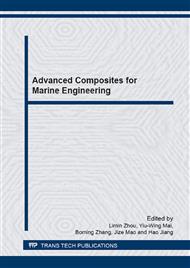p.181
p.188
p.194
p.202
p.210
p.220
p.243
p.250
p.258
Mechanical Characterisation of Composite Sandwich to Steel Joint for Marine Structures
Abstract:
Composite to metal joints are gradually found in the marine industry for the attachment of lightweight components to metallic structures. The puropose of this study is to invistigate the composite sandwich to steel joint for naval ships. The main emphasis of the study was placed on the mechanical properties of a hybrid joint between a sandwich glass fibre reinforced plastic superstructure and a steel hull. Based on the experiments of a base joint, a new numerical simulation method was used to analyze the performance of the base joint and the optimized joint. The optimized joint was presented due to reducing weight and avoiding eccentric load. The numerical predictions of the base hybrid joint showed a very good correlation with the experiment results, which validated the reliability of the new numerical simulation method. The strength of the optimized hybrid joint was evaluated through static simulation. This phenomenon is similar to the base joint. But there is no additional stress concentration induced by load eccentricity and internal bending. The optimized joint has 11% lower weight than the base joint, and the stress of the optimized joint is only about 4% ~ 67% of the base one. The results of the present work imply that the change of geometry and material is an effective method to improve the performance of the composite sandwich to steel joint.
Info:
Periodical:
Pages:
210-219
Citation:
Online since:
March 2015
Authors:
Price:
Сopyright:
© 2015 Trans Tech Publications Ltd. All Rights Reserved
Share:
Citation:


